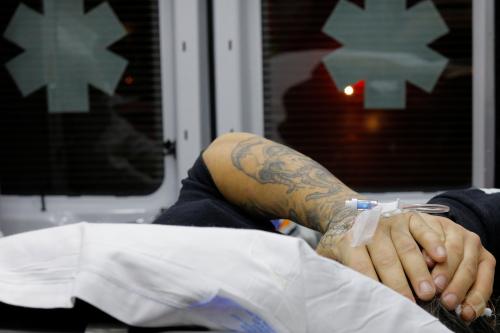COVID-19 has caused a perfect storm for our economy, society, and health. The pandemic is holding up a magnifying glass to our country’s deep inequities and challenges—including our crisis of deaths of despair. Over 3 million Americans have tested positive for the virus, and over 135,000 have died from it as of the time of this writing.
The United States—like many other advanced economies—was already dealing with the hollowing out of low-skilled jobs, which has resulted in a rise of populism and a backlash against globalization in many of them. Those trends are more than evident here. They are compounded, most notably, by the deaths of despair: deaths due to drug, alcohol, and suicide that have taken 1 million lives since 1999 primarily among less than college-educated non-Hispanic whites. These deaths are the starkest facet of the decline of the white working class.
COVID-19 delivered an unprecedented economic shock to our economy and to those around the world. Low-skilled workers are especially at risk. Recent estimates of the labor market fallout in the U.S., based on Gallup data from April, show that 18 percent of the labor force has been laid off (most temporarily), and 33 percent of the labor force is experiencing either unemployment or reduced working hours. The four week moving average for the insured unemployed for June was over 20 million, a figure which masks those who are unemployed but do not have unemployment insurance.
It is difficult to conceive of the long-term social costs of a dual health and economic shock of this magnitude. We know from the extensive literature on well-being and unemployment that virtually everywhere the link has been studied, it has been found to have significant and persistent negative effects on well-being in excess of those predicted by income losses alone. Lack of employment and of the related life purpose and social connections is strongly associated with despair-related deaths.
A 2017 study estimated that between 1999 and 2014, for each one percentage point increase in the county-level unemployment rate, opioid-related deaths increased by 3.6 percent per 100,000 people. Of course, a shock of today’s magnitude may play out slightly differently. For example, there may be less associated stigma as incidence is so widespread, or it may affect different places in different ways, as in the many economically depressed counties that already have a large percent of the population out of the labor force. Government action can have a large influence, as illustrated by some researchers’ estimates that poverty actually fell in April and May, due to some of the income-bolstering provisions of the CARES Act. Still it is difficult to imagine that there will not be severe and lasting effects.
Our work, based on the new “science” of well-being measurement, focuses on the links between well-being and ill-being—with a focus on hope—and life outcomes, ranging from health and longevity to labor force outcomes to social connections and friendships. In a number of different studies, we find that people with hope for the future are more likely to invest in those futures and fare better in the health and labor market arenas, that optimists live longer and are less likely to partake in risky behaviors that jeopardize their futures, and that poor African Americans and Hispanics in the U.S. are much more optimistic about the future than are their white counterparts. These same minority groups have significantly lower representation in the deaths of despair than whites. We also find that drops in optimism among less than college-educated whites began in the late 1970s, coinciding with the first declines in manufacturing. This suggested to us that our indicators of well-being and ill-being could have served as warning indicators of trouble among this group well before the upturn in deaths began.
We have recently been matching our markers of well-being and ill-being from Gallup data for the U.S. with the county-level trends in deaths of despair from the Centers for Diseases Control and Prevention (deaths due to alcohol disease, drug overdose, suicide, and accidental deaths) and find robust patterns in the association between lack of hope and worry, and the probability of dying of these deaths. We cannot claim causality given that individual-level desperation likely increases the probability of such deaths. Yet living in a place that has both high levels of these deaths and hollowed-out economies and communities also increases the likelihood of despair.
As a first step, we have built an interactive vulnerability indicator that shows the links between state-level trends in well-being (optimism and worry) and county-level trends in deaths of despair. Our indicator allows users to see how these accord with county- and state-level trends in poverty, unemployment, and average household income. As such, the indicator allows users to see how these trends vary by populations, by state and county, and their relationship with trends in well-being (and ill-being).
| Interactive: The Geography of Hope and Desperation in America
|
As is evident from scrolling through the interactive, there are often stark differences in average income and poverty indicators and mortality rates across counties within the same state. The counties that are coded dark black, for example, have higher levels of mortality than those with lighter shades of gray. Take, for example, Kentucky, a state with low levels of optimism and high levels of worry and of deaths of despair. Still there are big differences within the state. The southeastern part, which is coded dark black, has counties such as Knott and Pike with some of the highest rates of deaths of despair and poverty in the country, rates that are even worse than the state’s already bad average. California, a state with high levels of optimism and relatively high mean household income, also has places with very high levels of deaths of despair. Several counties in the north of the state, such as Shasta, stand out along these lines.
In the long run, we will update the indicator on a biannual basis so that it can serve as a warning indicator, as changes in well-being—such as notable drops in hope— are often precedents of despair-related trends and deaths.
Many of the same populations that are vulnerable to these deaths are also vulnerable to COVID-19 mortality. While COVID-19 first hit African Americans in urban areas disproportionately, the spread to rural areas will likely hit the same population that is vulnerable to deaths of despair the hardest, due to high levels of preexisting conditions such as diabetes, obesity, cardiovascular disease and high rates of smoking on the one hand, and of despair on the other.
A remarkable finding on this front, meanwhile, is that poor African Americans remain much more optimistic and report better health in the midst of COVID-19 than do low-income whites (who are less worried about contracting the disease) Over the next several months, we will be adding the mortality rates from COVID-19 into the indicator and comparing where and how they coincide with those in deaths of despair.
We will also explore the role of well-being in mediating these trends. An important difference is that despair may play a causal role in those deaths and that enhancing well-being can help prevent them. While objective health conditions such as diabetes, smoking, and cardiovascular disease are clearly linked to COVID-19 mortality, they tend to be at least in part behaviorally driven conditions, and we know that individuals with higher levels of well-being tend to suffer less from these conditions. But we simply do not know if well-being can play a mediating role in the links between COVID-19 incidence and mortality. We hope that the trends that our vulnerability indicator uncovers over time can inform this important question as we navigate difficult economic, health, and ill-being challenges in uncertain times.
The Brookings Institution is committed to quality, independence, and impact.
We are supported by a diverse array of funders. In line with our values and policies, each Brookings publication represents the sole views of its author(s).








Commentary
A new tool for tracking vulnerability and premature mortality in America
July 15, 2020